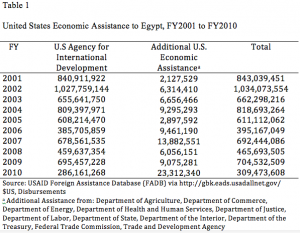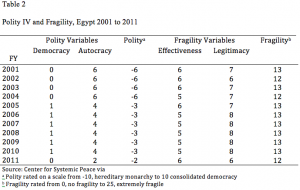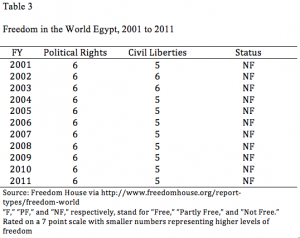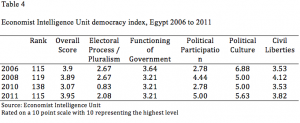Egypt remains one of the five “largest regular [U.S.] aid recipients in the Middle East” (Sharp, 2009, p.2). The following examines the effectiveness of U.S. foreign assistance to Egypt based on annual data reflective of U.S. aid expenditures and recipient nation movement in relation to U.S. foreign policy objectives from government and respected nongovernment sources from 2001-2010. Even without discussion of the recent instability in Egypt since 2010, key findings indicate that, over the period studied, U.S. nonmilitary assistance had little effect in forwarding U.S. policy objectives in Egypt.
Data collected from the U.S. Department of State’s strategic plan, echoing other State Department and Administration documents, indicates that U.S. foreign policy objectives in the Middle East include the promotion stability, economic reforms, and democracy (“Department of State,” 2007). Therefore, the effectiveness of U.S. assistance in the furtherance of these objectives should be reflected in data collected from respected sources assessing national movement in respect to these goals. Increased effectiveness would be indicated by a positive trend in national stability, economic prosperity, and democratic values. A neutral or negative trend in the data would be interpreted as the assistance being ineffectual or possibly having negative results.
In the ten years from 2001-2010 Egypt received over $6.5 billion in U.S. economic aid, $6.4 billion of which was from the U.S. Agency for International Development (USAID) with the remainder being from other U.S. agencies (see Table 1). Note, the figures below are representative of U.S. economic assistance only. Other forms of aid, to include military aid which amounts to a large portion of U.S. assistance provided Egypt, are not reflected.
The “Polity IV” index provides a gauge that measures qualities of democratic and autocratic authority based on a 21-point scale (Marshall and Jaggers, 2011). From 2001-2004, Egypt’s Polity IV overall rating of -6 leaned toward the -10 rating representative of a hereditary monarchy. In 2005, Egypt held the first multi-candidate presidential election in Egypt’s history That year, Polity IV shows an increase in Egypt’s democracy score and a decrease in autocracy resulting in an overall positive movement (see Table 2). In 2011, Polity IV shows a slight decrease in Egypt’s democracy rating but a continued decrease in the autocracy scale, thus presenting continued overall positive movement (see Table 2). Though, according to the Global Report 2011: Conflict Governance and State Fragility, “The relative strength and political activism of the Egyptian military present enormous challenges for the democratization process in that country […]” (Marshall & Cole, 2011, p. 20). The fragility score for Egypt showed slight improvement in 2011 (see Table 9). However, it remains a very fragile state, even when compared with other nations in the region.
“Freedom in the World” is an annual publication from Freedom House, a U.S. based democracy and human rights advocacy organization, which measures levels of freedom in nations and disputed territories around the world. Egypt showed little change between 2001 and 2011 in Freedom House’s “Freedom in the World” index. Scores for political freedom held at 6 while scores for civil liberties hovered between 5 and 6 (see Table 3). President Mubarak’s lessening of restrictions on print media and increased tolerance of political discourse (Freedom House, 2005) may have contributed to the slight decrease in Egypt’s 2004 civil liberty score, indicating positive movement. However, the country’s overall status for the period remained unchanged at ‘not free’.
Egypt’s overall score on the Economist Intelligence Unit’s “Democracy Index” for the years 2001-2011 ranged from 3.07 to 3.95 out of 10 (see table 4). The data derived from the “Democracy Index” speaks directly to levels of democratic change in the recipient nation. Between 2008 and 2011, Egypt’s electoral process/pluralism score went from 2.67 to 0.83 and back again. In 2010, Egypt amended its constitution to permit multiple candidates in presidential elections but limited the right to existing parties only, negatively affecting pluralism within the electoral process possibly accounting for the near two-point loss in this variable. In 2011, the overthrow of President Mubarak may have resulted in increased optimism concerning the future of pluralism within the electoral process, thus returning Egypt’s electoral process/pluralism rating to its 2008 level and raising Egypt’s political participation and political culture ratings to their highest levels to date in the index for this nation. However, the reasoning behind the increased electoral process/pluralism score in 2011 was not clarified in the final report.
In the midst of obvious growing instability, the Obama Administration requested $1.55 billion in total U.S aid to Egypt for Fiscal Year (FY) 2013, $250 million of which was targeted for economic aid (Sharp, 2012). This is in addition to the $1 billion in U.S. backed loan guarantees and $1 billion in bilateral debt relief proposed by President Obama since February 2011 (Sharp, 2012). However, at the time of this request Egyptian President Muhammad Morsi had already put into question his ability, or desire, to institute democratic reforms called for in January 2011’s revolution by granting new powers to his office resulting in protests condemning him as a new dictator, prompting a strike by Egypt’s judges, and eventually leading to his over through.
In the ten years covered by the data presented above, Egypt demonstrated positive movement in two of the four indices reviewed, the “Polity IV” index and “The Democracy Index.” However, Egypt’s high fragility score, lack of progress in either political rights or civil liberties, and continued ranking of ‘not free,’ puts into question the effectiveness of nonmilitary aid in advancing U.S. policy goals of promoting democracy, economic prosperity, and stability in the nation. The conflicting results lend themselves to a partially successful, or neutral, finding for U.S. nonmilitary aid’s effectiveness in Egypt between 2001 and 2011. Recent events, not covered by the data presented, would undoubtedly lean towards a continued reduction of U.S. ROI with respect to foreign aid’s effectiveness in promoting the U.S goals in the nation.




